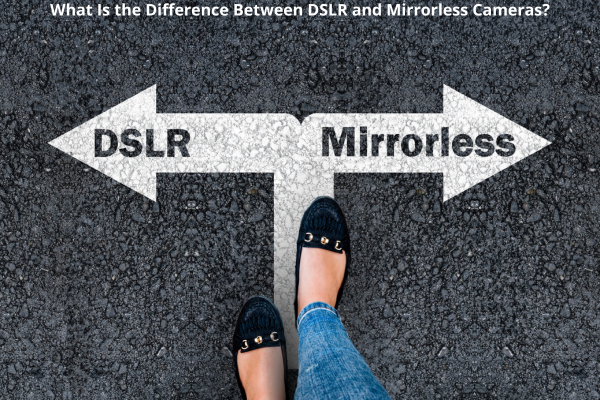If you’re new to photography, you’ve probably come across the terms DSLR and mirrorless. These are the two main types of digital cameras available today — and choosing between them is often one of the first decisions you’ll face.
In this guide, we’ll break down the key differences between DSLR and mirrorless cameras, their pros and cons, and how to decide which one is right for your needs.
What Is a DSLR Camera?
DSLR stands for Digital Single-Lens Reflex. It’s based on traditional film camera design, using a mirror and optical viewfinder system.
How It Works:
- Light enters the lens
- It reflects off a mirror inside the body
- The mirror directs light into an optical viewfinder
- When you press the shutter, the mirror flips up and the light hits the sensor
What Is a Mirrorless Camera?
Mirrorless cameras — as the name suggests — do not have a mirror. They use an electronic viewfinder (EVF) or just the LCD screen to preview the image.
How It Works:
- Light passes directly through the lens onto the image sensor
- The image is displayed on a screen or EVF in real time
- There’s no mirror or optical viewfinder
Side-by-Side Comparison
| Feature | DSLR | Mirrorless |
|---|---|---|
| Size & Weight | Larger, bulkier | Smaller, lighter |
| Viewfinder | Optical (OVF) | Electronic (EVF) or LCD |
| Autofocus (Live View) | Slower (older models) | Faster and more advanced |
| Battery Life | Longer | Shorter (due to EVF/LCD use) |
| Lens Options | Wide range, especially from Canon/Nikon | Growing selection, especially from Sony, Fujifilm, etc. |
| Image Quality | Excellent | Equally excellent |
| Video Capabilities | Good (limited in older models) | Superior (especially 4K+ support) |
| Price | Slightly cheaper for older models | Generally more expensive (newer tech) |
Pros and Cons of DSLR Cameras
✅ Pros:
- Optical viewfinder: No delay or lag
- Long battery life
- Durable and time-tested design
- Often more affordable on the used market
- Large number of third-party accessories and lenses
❌ Cons:
- Bulky and heavier
- Slower autofocus in live view
- Less advanced video features in older models
- Becoming less supported as brands focus on mirrorless development
Pros and Cons of Mirrorless Cameras
✅ Pros:
- Compact and lightweight: Easier to carry around
- Real-time exposure preview in EVF
- Faster and more accurate autofocus, especially for video
- Better performance with silent shooting
- Cutting-edge features (IBIS, eye-tracking, AI-assisted focus)
❌ Cons:
- Shorter battery life
- More expensive, especially newer models
- EVFs can lag slightly in low light (less common with newer cameras)
Popular DSLR Models for Beginners
- Canon EOS Rebel T7 / T8i
- Nikon D3500 / D5600
- Great value, especially when bought used
Popular Mirrorless Models for Beginners
- Sony ZV-E10
- Canon EOS R50
- Fujifilm X-T30 II
- Nikon Z30
These offer advanced autofocus, great video, and future-ready features.
Which Should You Choose?
Choose a DSLR if:
- You want a more affordable entry into photography
- You prefer an optical viewfinder
- You value battery life over compact size
- You’re okay with using slightly older tech
Choose a Mirrorless if:
- You want the latest features and future-proof gear
- You’re focused on video as well as photos
- You want faster, more accurate autofocus
- You prefer a smaller, lighter setup
Final Thoughts: Both Can Be Great — It Depends on You
DSLRs and mirrorless cameras both produce incredible photos. The choice really comes down to how you shoot, what you value, and your future goals.
If you already have DSLR gear, there’s no rush to switch. But if you’re buying your first camera and want cutting-edge features, mirrorless is likely the way to go.
